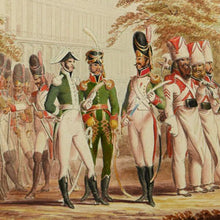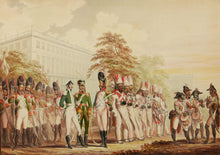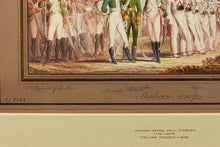Napoleonic Kingdom of Italy - 2nd Line Infantry, 1810
- Regular price
- £2,600
- Sale price
- £2,600
- Regular price
-
- Unit price
- /per
Adding product to your cart
Overall: 42cm (16.5in) x 50cm (19.7in)
Provenance: Sotheby’s, London, 29.11.2000
Pencil, ink and watercolour on paper. Uniform study of the officers, sappeurs, grenadiers and musicians of the Italian 2nd Line Infantry. Inscribed in the lower margin ‘2nd Regiment of the Line / Marshal / Colonel of the Regiment / Sappers’. Signed and dated lower right 'John Paul Fischer fecit London 1815'. Image: 20.5 x 29cm. Framed and glazed.
2° Reggimento Fanteria di Linea (2nd Line Infantry Regiment) was raised in 1805 following the creation of the Kingdom of Italy by Napoleon and the appointment of his stepson Eugene de Beauharnais as viceroy. The 2nd Line Infantry saw action across Europe, from the arid mountains of Southern Spain to the frozen steppes of Russia. It was expanded to four battalions in 1809. The 2nd battalion served Spain in 1808, while the rest fought the Austrians in Italy. All four, numbering 2776 men of all ranks, took part in the 1812 invasion of Russia.
Read more
The present watercolour is from a series by Johann George Paul Fischer illustrating the uniforms of the various armies involved in the Napoleonic Wars. One such set is held in the Royal Collection, and which was probably purchased by, or presented to, the Prince Regent. Johann George Paul Fischer (1786-1875) was born in Hanover and trained under the engraver Heinrich Ramberg (1763-1840) before being appointed court painter and picture restorer to the Duke of Bavaria. Coming to England in about 1810, he worked mainly in London and Cheltenham and became a highly successful portrait miniature painter. His royal patrons included Queen Charlotte (1744-1818), William IV (1765-1837) and Queen Victoria (1819-1901). Drawings and prints by Fischer are in the the British Museum, the Royal Collection and the National Portrait Gallery.








